Servicios Personalizados
Revista
Articulo
Indicadores
-
 Citado por SciELO
Citado por SciELO -
 Accesos
Accesos
Links relacionados
-
 Similares en
SciELO
Similares en
SciELO
Compartir
Revista mexicana de análisis de la conducta
versión impresa ISSN 0185-4534
Rev. mex. anál. conducta vol.36 no.2 México ene. 2010
Artículos de investigación empírica
The 'Huautli' alternative: Amaranth as reinforcer in operant procedures
La alternativa 'Huautli': el amaranto como reforzador en procedimientos operantes
Felipe Cabreraª, Beatriz Robayo–Castroª, and Pablo Covarrubiasb
ª Centro de Estudios e Investigaciones en Comportamiento (CEIC) CUCBA– Universidad de Guadalajara
b Universidad del Valle de México —campus Zapopan
To correspond please contact:
Felipe Cabrera,
Centro de Estudios e Investigaciones en Comportamiento (CEIC)
Centro Universitario de Ciencias Biológicas y Agropecuarias,
Universidad de Guadalajara.
Francisco de Quevedo 180.
Col. Arcos Vallarta CP 44130
Guadalajara, Jalisco, México.
Email: fcabrera@cencar.udg.mx
Recibido: Abril 30, 2010
Revisado: Junio 15, 2010
Aceptado: Junio 28, 2010
Abstract
The progressive ratio (PR) schedule of reinforcement is widely used to assess reinforcement strength. Rats typically complete higher ratio requirements for more palatable food. This effect is well characterized by the Mathematical Principles of Reinforcement (MPR). In this experiment, either standard food pellets or amaranth grain were delivered according to PR schedules, with requirements increasing in steps of 1 (PR 1) or 3 (PR 3). Rats completed higher ratio requirements and displayed shorter pre–ratio pauses for pellets than for amaranth. Nevertheless, run–rates were similar across reinforcers. In terms of the theoretical parameters of MPR, similar values in a parameter (which indices incentive value) were obtained for amaranth and pellet reinforcers. This finding suggests that, although amaranth engenders less responding than pellets, amaranth grain is a reliable reinforcer for operant procedures. The MPR model accounted for the differences in quality of food.
Key words: MPR model; progressive ratio schedules; food textures; amaranth; food pellets; rats.
Resumen
Un procedimiento comúnmente utilizado para evaluar la fuerza de un reforzador es el uso de programas de razón progresiva (RP) de reforzamiento. Las manipulaciones experimentales referentes a la calidad del reforzador en ratas han mostrado que, bajo programas de razón progresiva, los sujetos completan diferente número de razones dependiendo de la calidad del reforzador. En dichas manipulaciones los resultados han mostrado que el modelo de Principios Matemáticos de Reforzamiento (PMR) predice y explica adecuadamente los resultados. En este experimento, dos tipos de alimentos con diferente textura fueron entregados como reforzadores: pellas de alimento y granos de amaranto; dichos reforzadores se entregaron de acuerdo a dos tamaños de incremento del programa progresivo, RP 1 y RP 3. Los resultados mostraron que las ratas respondieron ligeramente más para recibir pellas de alimento que amaranto. Sin embargo, se observaron tasas de carrera muy semejantes ante ambos alimentos. En términos de los parámetros teóricos del modelo PMR, se obtuvieron valores similares del parámetro a (i.e. valor del incentivo) para amaranto que para pellas de alimento. Este hallazgo sugiere que el amaranto puede ser utilizado como reforzador tanto como las pellas de alimento. El modelo PMR explicó las diferencias en la calidad del reforzador.
Palabras clave: modelo de Principios matemáticos de Reforzamiento; programas de razón progresiva; texturas del alimento; amaranto; pellas de alimento; ratas.
The origins of the pelletized food
Aiming at providing a behavioral account of drive, particularly hunger, Skinner (1932a, 1932b) developed a system that allowed an objective measurement of hunger. In contrast with the free feeding procedure used by Richter (1927), who observed the distribution of eating periods in rats, Skinner studied the rate of eating within each feeding period. The accurate measurement of eating rate required special experimental apparatus and procedures. Skinner (1932a, 1932b, 1932c) thoroughly described three of them: the response device, the food–dispenser device, and the characteristics of food preparation. The preparation of food involved breaking a dry stiff mash into standardized pellets. The homogeneous pelletized food was important to reduce the variance between pieces of food obtained by the rats. The food dispenser device first consisted of just a food tray containing pellets placed underneath a light flap, below the level of the cage's floor. To obtain the food rats had to push the flap and pick the pellet from the tray. Afterwards, the food dispenser device was a wooden disc that delivered the pellets through small holes around the disc's perimeter, dropping the pellets into a receptacle (see Skinner, 1956, Figure 8). To record the responses, an electronic contact was connected to the response device (a door that the rats pushed inward with the head or a lever that the rats pressed with their forepaws). Each time the rats opened the door or pressed the lever, the mechanism was operated and the device recorded that a piece of food was obtained. Since Skinner's most important interest was to obtain a measurement of the strength of the feeding behavior, the number of pieces eaten per unit of time (i.e. the rate of eating) was fundamental. Thus, food prepared in pellets was a basic methodological requirement for the analysis of feeding behavior.
Ever since Skinner (1932a), the food used as reinforcer is typically pelletized. Nowadays, manufacturers have developed pellet dispenser devices that require high precision pellets; otherwise the pellet dispenser would malfunction. Although different food qualities and flavors have been developed (e.g., grain–based pellets, sucrose pellets, flavored pellets), most food reinforcers are pellet shaped. Even though rate of responding displaced rate of eating as the most important measure in behavior analysis (see Skinner, 1938), food remains in use as reinforcer, among other qualitatively different reinforcers (see Dunham, 1977) like drugs, brain stimulation (Wise, 1996), access to locomotor activity (Hundt & Premack, 1963), sexual activity (Crawford, Holloway & Domjan, 1993), etc.
In contrast with experiments conducted with rats, studies with pigeons have used a wide diversity of grains (e.g., mile, hemp seeds, corn, millet, vetch grain, etc., and the mixtures of some of them). Different responding pattern has been found using different types of grain; Bizo and Killeen (1997) used corn, mile and millet to reinforce pigeons responding under Fixed Ratio (FR) schedules. They found that the corn engendered more responding, followed by the milo, and finally the millet. Nevertheless, all this variety of grain might be used to reinforce pigeons' responding. When rats are used in operant procedures, only pelletized food is used as reinforcer . This paper evaluates the use of amaranth grain as an alternative to pellets, serving as a reliable and accessible food reinforcer in operant research.
The amaranth grain
The amaranth grain (named 'Huautli' in the nahuatl language), was a basic food in pre–Columbian civilizations (De Sahagún, 1570/1990). Aztecs, Incas and other peoples cultivated and processed this grain for human consumption and rituals. Amaranth fell into disuse after Spanish conquest. Nowadays, this food has become among the most promising crops of the world (National Research Council, 1984).
According to the Integrated Taxonomic Information System profile (ITIS, 2009), there are about 45 species of amaranth. From the family of Amaranthaceae, the amaranth belongs to the group of dicotyledonous. The amaranth specie used in this experiment is the Amaranthus cruentus L., whose common name is 'red amaranth'.
Studying diverse amaranth species, Sleugh et al. (2001) found that the nutritive values of the amaranth are of good quality, high in vitamins and proteins. The amaranth contains 16–17% of proteins comparative to the 12–14% of the wheat, 7–10% of the rice, and 9–10% of the corn (Muñoz–Gómez, Gaytán–Ruelas, Lugo–Arredondo, Martínez–Romero & Flores–Jiménez, 2005; National Research Council, 1984).
The effect of the amaranth's nutritional properties on the health has been tested in laboratory rats. Escudero, Zirulnik, Gomez, Mucciarelli, and Giménes (2006), exposed to albino wistar rats to the effect of a protein concentrate of red amaranth (Amaranthus cruentus L.), on the control of cholesterol and triglycerides. Among the more significant results, they found a hypotrigliceridemic action of the amaranth on the rats; that is, the addition of the protein concentrate of the amaranth to the rats caused a decreased in triglycerides and cholesterol in liver, increased concentration of High–density lipoprotein (HDL–C, also called 'good cholesterol') and decreased the Low–density lipoprotein (LDL–C, also called 'bad cholesterol'), increased excretion of lipids and cholesterol in feces, and increased antioxidant parameters. All those findings suggested that the amaranth is a good diet supplement that protects from cardiovascular diseases (Escudero et al, 2006; Gorinstein et al, 2007). Similar results were obtained by Grajeta (1999) using buffalo rats; the amaranth significantly decreased the level of total cholesterol in blood serum and in the liver.
Amaranth in operant procedures
Some physical properties of the amaranth make it an appropriate grain to be used in food–dispenser devices. Given that the density of puffed amaranth is 115.28 kg/m3, and porosity is 69.36% (Muñoz–Gómez et al, 2005), this grain is enough light and soft that do not cause malfunction in food–dispenser, but has the enough mass to fall inside the holes of the hopper to be ejected by a food–dispenser pulse (the puffed amaranth has a diameter between 0.9– 1.7 mm and the hopper's holes has a diameter about 3.56 mm diameter).
Because its nutritional value (see Table 1), amaranth can be used in prolonged experiments. Maciel (2010) exposed rats to a six months experiment comparing open and closed economies and delivered amaranth grain as the only food resource (i.e. no other supplemental food was used). All rats remained healthy throughout the 6 months of the experiment eating only amaranth.
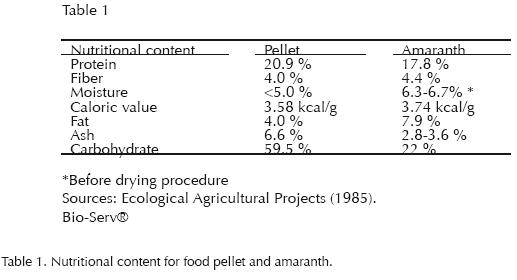
How attractive is the amaranth for rodents?
The incentive properties of a reinforcer are estimated by measuring the extent the subjects engage in an activity to obtain food. Since the main question we address on this paper is how reliable is the amaranth as reinforcer, subjects were required to respond under a progressive ratio (PR) schedule of reinforcement to determinate how much the rats respond for amaranth. Under the PR schedules, the response requirement for obtaining food is increased systematically with each successive reward obtained. The highest ratio achieved within a time–constrained session (Aberman, Ward & Salamone, 1998) or the maximum ratio requirement at which the animal ceases responding (Hodos & Kalman, 1963) is named 'break point'. The break point of progressive ratio is suggested as a reliable index of the reinforcement strength (Hodos, 1961; Hodos & Kalman, 1963) and has been widely used to evaluate optimal giving–up decisions in foraging simulations with gradual patch depletion (e.g. Kacelnik, Houston & Krebs, 1981; Timberlake, 1984; Wanchisen, Tatham & Hineline, 1988). Nonetheless, some have suggested that the break point might be affected by changes in both the reinforcement efficacy and motor factors of the organisms (Mobini, Chiang, Ho, Bradshaw & Szabadi, 2000). A precise characterization of such factors could be obtained from the Mathematical Principles of Reinforcement (MPR).
The MPR model (Killeen, 1994) accounts and predicts operant behavior under fixed ratio (FR) schedules of reinforcement (Killeen & Sitomer, 2003), and recently has been generalized to describe responding under progressive ratio (PR) schedules (see Killeen, Posadas–Sanchez, Borgå–Johansen & Thrailkill, 2009).
The performance under ratio schedules is described as follows:

where B designates response rate, and N designates the ratio requirement. This equation predicts an inverted —U function, and its shape is defined by three parameters: λ defines the slope of the ascending function, δ defines the height of the peak, corresponding to the theoretical maximum response rate, and a (i.e. specific activation) determinates the x– intercept of the function (i.e. the slope of the descending limb).
Bradshaw and colleges (Zhang et al, 2005a), assessed the drug–effects under PR schedules and describe their findings according to the MPR parameters. They demonstrated that the parameter a in Equation 1 was an index of reinforcer efficacy or incentive value, and the parameter δ was sensitive to changes in motor capability of the organism (Mobini et al, 2000; Zhang et al, 2005b; see also Bizo & Killeen, 1997).
The parameter a has been tested in rats using different magnitudes (Bizo, Kettle & Killeen, 2001) and quality of food (Reilly, 2003). Recently, Covarrubias and Aparicio (2008) assessed the effects of reinforcer quality (saccharin pellets and food pellets) under two step–sizes progressive ratio schedules, using rats as subjects. They showed that the parameter a (specific activation) was affected not only by the quality of reinforcement (saccharin > food pellets) but also by the motor effort requirement (PR 3 > PR 1), which support the assumption that a higher response effort preceding a reinforcer increases its effective value (Zentall & Singer, 2007).
Reilly (2003) extended the generality of the MPR by using a five–component multiple fixed–ratio schedule and three different reinforcers: sucrose pellets, food pellets, and a 50–50% mixture of food and sucrose pellets. Reilly found the highest incentive values (a parameter) for sucrose pellets, followed by the mixture, and finally the food pellets. Although previous studies (e.g. Covarrubias & Aparicio, 2008; Reilly, 2003) have assessed different reinforcer qualities, the present experiment had the purposes of, 1) evaluate the efficacy of the amaranth as a reinforcer, and 2) extend the MPR generality by using reinforcers of different texture and presentation (amaranth vs. food pellet). With these purposes, either food pellets or puffed amaranth grain were delivered according to PR schedules, with requirements increasing in steps of 1 (PR 1) or 3 (PR 3).
Method
Subjects
Seven naïve male albino rats (numbered R1 to R7) served as subjects. Rats were approximately 150 days old at the beginning of the experiment and were maintained at 85% (± 10 g) from their free–feeding body weight. Rats had free access to water and they were individually housed in a controlled temperature colony–room, and exposed to a daily 12 h: 12 h light: dark cycle.
Apparatus and materials
Seven rectangular chambers measuring 4.7 x 9.0 x 16.8 cm were used. In the front panel each chamber was equipped with a 5 cm wide and 5 cm high food–pellet receptacle (MED ENV–200R2M) located 3 cm above the floor. A fixed response lever (MED ENV–110M) 4.8 wide x1.9 cm long, requiring a force of 0.2 N to operate was mounted 3 cm above the food receptacle. The front and back walls were made of aluminum, and the top and side walls were made of clear polycarbonate. The chambers were enveloped with a white opaque cloth cover (Blackout fabric) to avoid interference from the room. A food dispenser (MED ENV–203) located behind the front wall delivered the food into the food receptacle. Two food types were used as reward; one food was grain–based pellets (45 mg Dustless precision pellets Bioserv Diet®), the other food was natural puffed amaranth grain (Amaranthus cruentus L.) acquired from a traditional marketplace. Since the amaranth was not bought in packages but in bulk, it was sifted to remove little particles.
Procedure
Prior to the experiment the amount of amaranth delivered by a single dispenser's pulse (0.5 s turn–on duration) was measured, and subsequently it was calculated how many discharges of amaranth were required to match the 45 mg of the pellet weight. 100 pulses were emitted to obtain data. The weight of the amaranth was obtained by a high precision scale (Precisa Balances® BJ–Series, with 102 g capacity and 0.001g readability). Figure 1 shows the weight's frequency distribution of amaranth discharged by the 100 pulses. The histogram shows that each single 0.5 s pulse discharged a range from 3 to 7 mg of amaranth, with a mode of 5 mg, average 4.99 mg, and SD = 0.93. The average number of pulses required to match the 45 mg is showed in Figure 2. This figure shows that the average milligrams (continuous line) of amaranth delivered given by ten sets of nine pulses of the food dispenser (black dots) matched the 45 mg of a pellet (open circle).

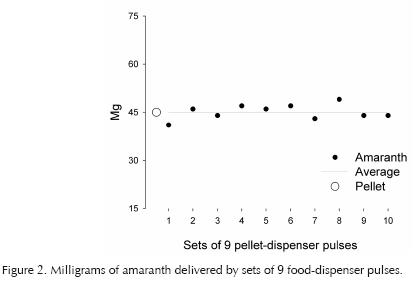
Training
Rats were trained to press the lever using a continuous reinforced schedule (CRF). Subjects R1, R2, R3, and R4 were trained with amaranth, while subjects R5, R6 and R7 were trained with pellets. Free food was left on the hopper at the beginning of the training session to guarantee the subjects make contact with the food inside the hopper. After 80 lever presses rats began the experiment. All rats reach the 80 lever presses criterion in the first session.
Experimental sessions
Rats were exposed to a progressive ratio schedule of reinforcement (PR) with two arithmetic step–size ratio progressions. In phases 1 and 3 a PR 1 was used, and in phases 2 and 4 a PR 3 was used. Phases' duration depended of the number of sessions necessary to reach a steady–state. The steady–state was defined as lack of tendency to increase or decrease the breakpoint in at least five sessions. Four subjects (R1, R2, R3, and R4) received amaranth as reinforcer in Phase 1 (30 sessions under PR 1 contingency) and Phase 2 (15 sessions under a PR 3 contingency). Subsequently, the subjects passed through the same step–sizes progressions (PR 1 and PR 3) but receiving pellets as reinforcers: 20 sessions under PR 1, and 15 sessions under PR 3. For the remaining subjects (R5, R6, and R7) the same step–sizes sequences were in effect, but with reverse order of food presentation: food pellets for phases 1 and 2, and amaranth for phases 3 and 4 (see Table 2). All sessions lasted for 60 min, and six sessions a week were conducted. In order to avoid the change of two variables at a time, a 5–days redetermination condition to PR 1 was interposed between phases 2 and 3. Data of these sessions were not included in data analysis.

Data analysis
The last 5 sessions of each phase were used to data representation. Dependent variables were the breakpoint of responses, the response rate, the post reinforcement pause (PRP), and the run rate. The breakpoint was the average of highest completed ratio on each progression. The response rate was measured as the number of responses emitted on the lever to complete the ratio since the last reinforcement. The Equation 1 was fitted to the response–rate data using the solver tool from Excel Microsoft®. The PRP was considered the time elapsed since the last pellet–dispenser pulse to the first lever response. The run–rate was measured as the time the rats required to complete the ratio minus the PRP. In the case of the amaranth, the delivery duration of the 9 discharges of the food dispenser was subtracted from the pause (9 s). Steady–state was considered when the breakpoint did not show a tendency to increase or decrease. The comparison across conditions was tested by repeated–measures analyses of variance (ANOVA).
Results
Figure 3 shows the average for the highest completed ratio across rats and phases as a function of the food reinforcer quality and the progressive ratio requirement. The completed ratio for pellet was higher than amaranth under PR 1 (F1,28 =12.10, p =.005) but not significantly under PR 3 (F1,28 =1.68, p =.22); the breakpoint values, in general were higher under PR 3 than under PR 1.
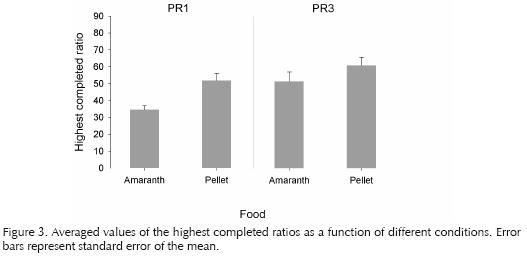
The response rates under PR1 and PR3 are showed in Figures 4 and 5 for each rat as a function of the completed ratios. Black circles represent the response rate to the amaranth food, the open circles the response rate to the pellets, and solid lines represent the best fit obtained with Equation 1. The response rate under PR1 (Figure 4) was higher for the pellet than for the amaranth in all subjects. Similarly, the response rate under PR3 (Figure 5) was in general higher for pellet than for amaranth. However, subjects R4, R5, and R6 reached higher response rates for the amaranth than for the pellet at higher ratios (i.e. lately within the session)

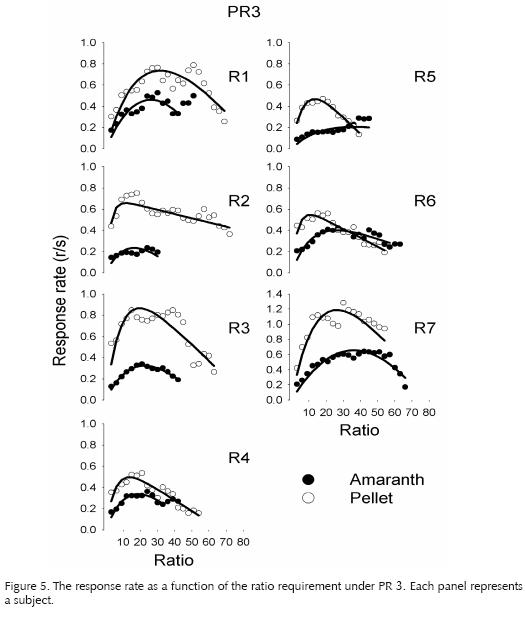
The averaged parameters α, δ and λ from Equation 1, corresponding to specific activation for incentive value, motor factors, and coupling are shown in Figure 6. Although the specific activation (a), under PR 1 was higher for pellet than for amaranth, no significant difference was found for food qualities (F1,28 =1.16, p=.29) nor PR requirements (F1,28 =0.29, p =.60). With regard to the motor demand of the task (parameter δ), the middle panel of Figure 6 shows larger values for amaranth than for pellet reinforcers under both PR 1 and PR 3 schedules; nevertheless, no significant differences were found (F1,28 =2.9, p =0.1). Values for λ parameter (right panel) were always higher for pellet than for amaranth (in both PR 1 and PR 3), with notably short values for amaranth under PR 3 schedule. No significant differences were found (F1,28 =3.84, p=.06). The individual best fitting values of the δ, λ, and α parameters, with the corresponding r2 values, are shown in Table 3.
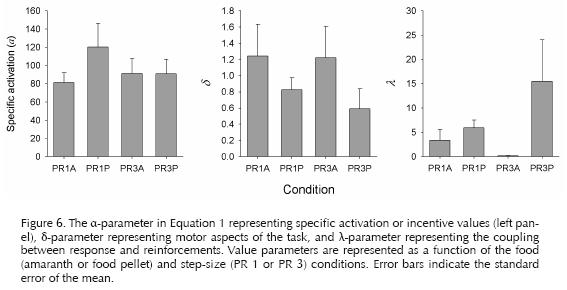

Given that the 45 mg of amaranth (several pieces of grain in the food receptacle) surely demanded to spend more time and effort to get it into the mouth than the 45 mg pellet, the run–rate (i.e. response rate minus the post–reinforcement pause) was obtained and represented in figures 7 and 8, corresponding to step–size PR 1 and PR 3. Figures 7 and 8 show that under both progressions, PR 1 and PR 3, the average run–rate was almost identical for the amaranth (filled circles) and for the food pellet (open circles), with slightly lower rates for the amaranth reinforcer. Even one subject (R6) reached slightly higher run–rates values with amaranth than with pellets under both PR 1 and PR 3 schedules. In general, the run–rate decrease as subjects completed the progressive ratios (but see R4 which showed high variability under PR 1).

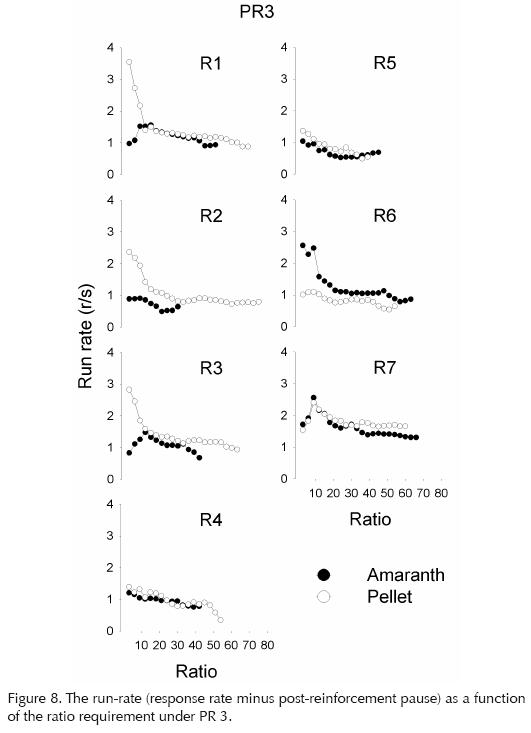
As a complementary result for the run–rate analysis, the post–reinforcement pause (PRP) was obtained and plotted as a function of the completed ratio (figures 9 and 10). Both figures show that the PRP increased as a function of completed ratios (note the log y–axis). All subjects in all conditions had larger pauses after receiving the amaranth than after the pellets.
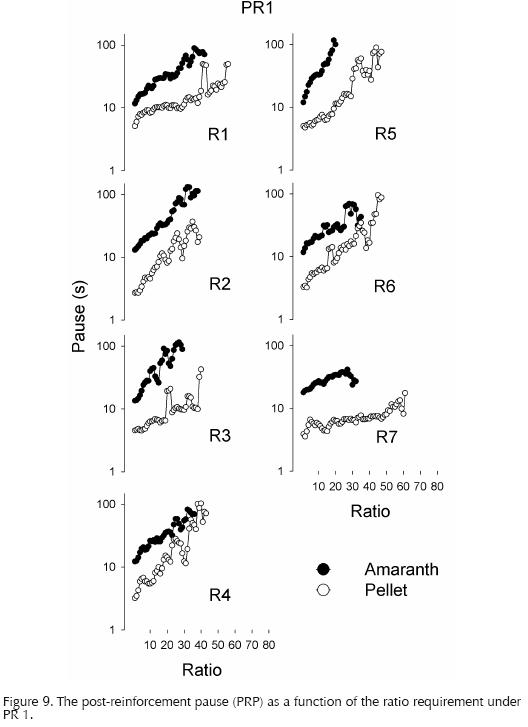
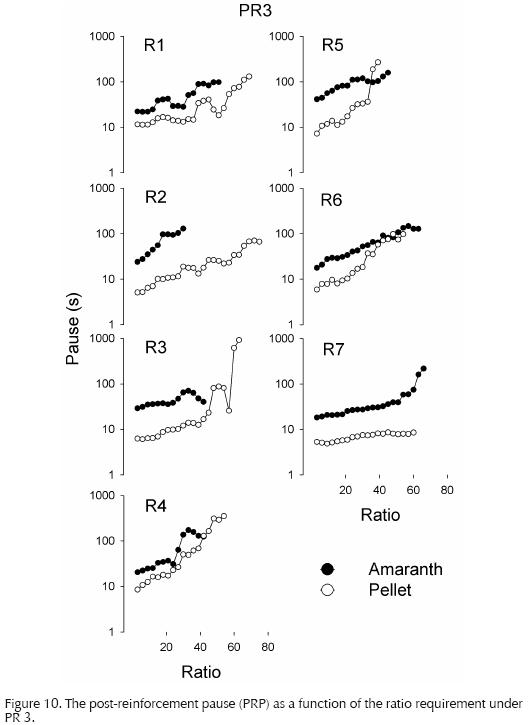
Discussion
The present study evaluated how adequate is the amaranth as an alternative to pellets in operant research. Our results suggested that delivering grains instead of a single pellet could engendered different responding patterns and might promote also different consummatory responses.
Concerning the responding patterns, results showed that rats reached slightly higher break points when they responded for pellets than when they responded for amaranth. Although the rats showed larger response rates for pellets than for amaranth, the estimated incentive value (a parameter in Equation 1) was higher for pellets only under PR 1; under PR 3 slightly higher values were observed for amaranth than for pellet. These results suggest that the amaranth's incentive value is comparable to the value of the food pellet.
If amaranth is as valuable as the food pellet, why lower response rate was observed? When the PRP was subtracted from the response rate to obtain the run–rate analysis, no differences between pellet and amaranth were found. Conclusively, the larger PRP caused the low rate of responding when the amaranth was the reinforcer. Some amaranth's properties could then be interacting with the rate of responding, and certainly picking the amaranth from the hopper was different than for the pellet.
Concerning picking the food from the hopper, we observed that rats suddenly took up and ate the pellet from the hopper (less than 1 s) while the 45 mg of amaranth grain was taken up and eaten more slowly (around 18 s). Regarding to the original suggestion of Skinner (1932a) for using pelletized food, it was precisely that this food preparation "reduced the rate of eating to the rate at which the pellets are taken up by the rat" (p. 24). Similarly, using pigeons as subjects, Bizo and Killeen (1997) observed that the subjects tended to pick up a single piece of grain per peck, independently of the grain size. In the case of the amaranth, the rats spent more time consuming all grains equivalent to the 45 mg of food from the food receptacle than consuming a single 45 mg pellet. This time enlarged the PRP, and consequently decreases the response rate.
Because most of the operant research with rats has used pellets as reinforcers, little is known about effects of different food textures1; nevertheless, the food texture is a critical feature that contributes to food preferences (Rosenthal, 1999). Eating food with a particular texture provoke a specific feeding pattern (mastication and swallowing). In the case of amaranth, we found that rats used the tongue to pick up the amaranth by licking the hoper.
Heath and Prinz (1999) pointed out that the masticatory sequence is divided in three: a) ingestion and transfer of food to between the teeth and tongue, b) rhythmic chewing in which the food is comminuted and the bolus formed, and c) clearance and swallowing. If the food consistency modifies masticatory patterns (Rosenthal, 1999), then the amaranth surely engendered different pattern of mandibular jaw movements, duration of the mastication cycle, and the number of cycles preceding the swallow (see Pereira, Duarte Gaviao & Van Der Bilt, 2006). These eating differences stimulated by the amaranth could have contributed to obtain the lower value of the parameter a under the PR 1 schedule. Research has shown that under small ratio schedules a reinforcer strengthens not only the target response, but also consummatory activities (Bizo et al, 2001; Timberlake, 2001); these consummatory activities could then decrease response rate, in a similar way that the paradoxical incentive effect reported by Bizo et al (2001); when two or three pellets were delivered as reinforcer more consummatory activities were elicited, overshadowing target responses (i.e. pressing the lever). The effect of these activities related to the amaranth consumption could decrease the slope of ascending function (parameter λ) and the slope of descending limb (parameter α). Nevertheless, the extremely low values in parameter λ for amaranth under PR 3 is unusual since more target responses (i.e. lever pressing) should be coupled by each reinforcer delivered.
Although the same physical effort (i.e. pressing the lever) was required to obtain both amaranth and pellet, and similar run–rates were observed between amaranth and pellet reinforcers, picking the amaranth grain from the hoper could impose a higher motor demand, slowing down the response rate. This assumption could be confirmed by the higher values in parameter δ observed when amaranth was the reinforcer. Nevertheless, this result did not replicate the finding of Covarrubias and Aparicio (2008) who observed that higher response effort preceding a reinforcer increased its effective value (also see Zental & Singer, 2007). Future research should address the effects of grain delivery on responding pattern in rats. However, the amaranth could be used as a reliable reinforcer in operant procedures having some attractive qualities like a) the use of magnitudes less than 45 mg (one pulse ejects 5 mg of amaranth), b) it is dustless, so the food dispenser is not stocked by amaranth residues, c) if maintained in dried ambient, it hasn't caducity date, and d) it is an affordable product.
References
Aberman, J.E., Ward, S.J., & Salamone, J.D. (1998). Effects of dopamine antagonists and accumbens dopamine depletions on time–constrained progressive–ratio performance. Pharmacology Biochemistry and Behavior, 61, 341–348. [ Links ]
Bizo, L.A., Kettle, L.C., & Killeen, P.R. (2001). Rats don't always respond faster for more food: The paradoxical incentive effect. Animal Learning and Behavior, 29, 66–78. [ Links ]
Bizo, L.A. & Killeen, P.R. (1997). Models of ratio schedule performance. Journal of Experimental Psychology: Animal Behavior Processes, 23, 351–367. [ Links ]
Covarrubias, P., & Aparicio, C.F. (2008). Effects of reinforcer quality and step size on rats' performance under progressive ratio schedules. Behavioural Processes, 78, 246–252. [ Links ]
Crawford, L. L., Holloway, K, S., & Domjan, M. (1993). The nature of sexual reinforcement. Journal of the Experimental Analysis of Behavior, 60, 55–66. [ Links ]
De Sahagún, B. (1570/1990). Historia general de las cosas de la Nueva España. Madrid: Historia 16 editorial. [ Links ]
Dunham, P. (1977). The nature of reinforcing stimuli. In W.K. Honig & J.E.R. Staddon (Eds.), Handbook of operant behavior (pp. 98–124). Englewood Cliffs, N.J: Prentice Hall. [ Links ]
Escudero, N.L., Zirulnik, F., Gomez., N. N., Mucciarelli S. I., & Giménes, M.S. (2006). Influence of a protein concentrate form Amaranthus cruentus seeds on lipid metabolism. Experimental Biology and Medicine, 231, 50–59. [ Links ]
Fantino, E. (1991). Behavioral Ecology. In I. Iversen and K. A. Lattal (Eds.), Experimental analysis of behavior: Vol. I (pp. 117–153). Amsterdam: Elsevier Science Publishers. [ Links ]
Gorinstein, S., Medina–Vargas, O.J., Jaramillo, N. O., Arnao–Salas, I., Martínez–Ayala, A. L., Arancibia–Avila, P., Toledo, F., Katrich, E., &., Trakhtenberg, S. (2007). The total polyphenols and the antioxidant potentials of some selected cereals and pseudocereals. European Food Research and Thechnology, 225, 321–328. [ Links ]
Grajeta, H. (1999). Effect of amaranthand oat bran on blood serum and liver lipids in rats depending on the kind of dietary fats. Food, 43, 114–117. [ Links ]
Heath, M. R., & Prinz, J.F. (1999). Oral processing of foods and the sensory evaluation of texture. In A. J. Rosenthal (Ed.), Food texture. Measurement and perception (pp. 18–29). Aspen Publishers. U.S.A. [ Links ]
Hodos, W. (1961). Progressive ratio as a measure of reward strength. Science, 134, 943–944. [ Links ]
Hodos, W., & Kalman, G. (1963). Effects of increment size and reinforce volume on progressive ratio performance. Journal of the Experimental Analysis of Behavior, 6, 387–392. [ Links ]
Hundt, A.G. & Premack, D. (1963). Running as both a positive and negative reinforcer. Science, 142, 1087–1088. [ Links ]
Institute of Food Technologies (1985). Amaranth: Composition, properties, and applications of a rediscovered food crop. Ecological Agricultural Projects. McGill University [on line], retrieved 04/16/2010. http://eap.mcgill.ca/CPAT_1.htm. [ Links ]
Integrated Taxonomic Integration System (2009). ITIS [on line database], retrieved 04/15/2010. http://www.itis.gov/index.html. [ Links ]
Kacelnick, A., Houston, A.I., & Krebs, J.R. (1981). Optimal foraging and territorial defence in the Great Tit (Parus major). Behavioral Ecology and Sociobiology, 8, 35–40. [ Links ]
Killeen, P.R. (1994). Mathematical principles of reinforcement. Behavioral and Brian Sciences, 17, 105–172. [ Links ]
Killeen, P.R., Posadas–Sánchez, D., Borga–Johansen, E., & Thrailkill, E. (2009). Progresive ratio schedules of reinforcement. Journal of Experimental Psychology: Animal Behavior Processes, 35, 35–50. [ Links ]
Killeen, P.R. & Sitomer, M.T. (2003). MPR. Behavioural Processes, 62, 49–64. [ Links ]
Maciel, R.P. (2010). Búsqueda de alimento en ratas: efecto de economías abiertas y cerradas. Unpublished master's thesis, University of Guadalajara, Guadalajara Jal, México. [ Links ]
Muñoz–Gómez, F., Gaytán–Ruelas, J.G., Lugo–Arredondo, M., Martínez–Romero, J., & Flores–Jiménez, E. (2005). Production of a machine to explode grains of Amaranth. Revista Ciencias Técnicas Agropecuarias, 14, 1–9. [ Links ]
National Research Council (1984). Amaranth: Modern prospects for ancient crop. [On line] National Academy Press: Washington D.C. Retrieved 04/13/2010. http://www.appropedia.org/Original:Amaranth_Modern_Prospects_for_an_Ancient_Crop. [ Links ]
Pereira, L. J., Duarte Gaviao, M. B., & Van Der Bilt A. (2006). Influence of oral characteristics and food products on masticatory function. Acta Odontologica Scandinava, 64, 193–201. [ Links ]
Reilly, M.P. (2003). Extending mathematical principles of reinforcement into the domain of behavioral pharmacology. Behavioural Processes, 62, 75–88. [ Links ]
Rosenthal, A.J. (1999). Relation between instrumental and sensory measures of food texture. In A. J. Rosenthal (Ed.), Food texture. Measurement and perception (pp. 1–17). Aspen Publishers. U.S.A. [ Links ]
Sibbing, F.A. (1991). Food processing by mastication in cyprinid fish. In J.F.V. Vincent & P.J. Lillford (Eds.), Feeding and the texture of food (pp. 57–92). Cambridge University Press: Cambridge. [ Links ]
Skinner, B.F. (1932a). Drive and reflex strength I. Journal of General Psychology, 6, 22–37. [ Links ]
Skinner, B.F. (1932b). Drive and reflex strength II. Journal of General Psychology, 6, 38–48. [ Links ]
Skinner, B.F. (1932c). On the rate of formation of a conditioned reflex. Journal of General Psychology, 7, 274–286. [ Links ]
Skinner, B.F. (1938). The behavior of organisms. Appleton–Century–Crofts: New York. [ Links ]
Skinner, B.F. (1956). A case history in scientific method. American Psychologist, 11, 221–233. [ Links ]
Sleugh, B. B., Moore, K,J., Brummer, E.C., Knapp, A.D., Russell, J., & Gibson, L. (2001). Crop quality & utilization. Crop Science, 41, 466–472. [ Links ]
Stephens, D.W., & Krebs, J.R. (1986). Foraging theory. Princeton University Press: United Kingdom. [ Links ]
Timberlake, W. (1984). A temporal limit on the effect of future food on current performance in an analogue of foraging and welfare. Journal of the Experimental Analysis of Behavior, 41, 117–124. [ Links ]
Timberlake, W. (2001). Motivational modes in behavior systems. In R.R. Mowrer and S.B. Klein (Eds.), Handbook of contemporary learning theories (pp. 155–209). New Jersey: Lawrence Erlbaum Associates. [ Links ]
Wanchisen, B.A., Thatam, T.A., and Hineline, P.N. (1988). Pigeons' choices in situations of diminishing returns: Fixed versus progressive–ratio schedules of reinforcement. Journal of the Experimental Analysis of Behavior, 50, 375–394. [ Links ]
Wise, R.A. (1996). Addictive drugs and brain stimulation reward. Annual Review of Neuroscience, 19, 319–340. [ Links ]
Zentall, T.R., & Singer, R.A. (2007). Within–trial contrast: pigeons prefer conditioned reinforcers that follow a relatively more rather than a less aversive event. Journal of the Experimental Analysis of Behavior, 88, 131–149. [ Links ]
Zhang, Z., Rickard, J.F., Asgari, K., Body, S., Bradshaw, C.M., Szabadi, E. (2005a). Quantitative analysis of the effects of some "atypical" and "conventional" antipsychotivs on progressive ratio schedule performance. Psychopharmacology, 179, 489–497. [ Links ]
Zhang, Z., Rickard, J.F., Body, S., Asgari, K., Bradshaw, C.M., Szabadi, E. (2005b). Comparison of the effects of clozapine and 8–hydroxy–2–(di–n–propylamino) tetralin (8–OH–DPAT) on progressive ratio schedule performance: evidence against the involvement of 5–HT1A receptors in the behavioural effects of clozapine. Psychopharmacology, 181, 381–391. [ Links ]
Note
The experiment was financed by UDG–PTC–316 (PROMEP– Secretaría de Educación Pública), granted to the first author, responsible for the job coordination. Second author carried out the experiment and participated in the design and document preparation, and the third author participated in design, data analysis and composition. Authors would like to thank Federico Sanabria for valuable and insightful comments, and Roberto P. Maciel pioneer using amaranth as food reinforcer.














